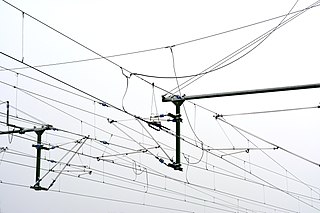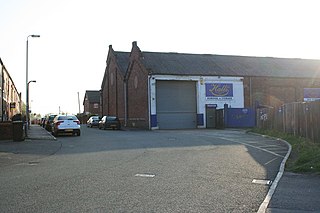
A tram is a type of urban rail transit consisting of a rail vehicle, either alone or coupled as a self-propelled train through a multiple unit, that runs on tramway tracks on urban public streets; some include segments on segregated right-of-way. The tramlines or networks operated as public transport are called tramways or simply trams/streetcars. Many recently built tramways use the contemporary term light rail.

An overhead line or overhead wire is an electrical cable that is used to transmit electrical energy to electric locomotives, trolleybuses or trams. The generic term used by the International Union of Railways for the technology is overhead line. It is known variously as overhead catenary, overhead contact line (OCL), overhead contact system (OCS), overhead equipment (OHE), overhead line equipment, overhead lines (OHL), overhead wiring (OHW), traction wire, and trolley wire.

Piran is a town in southwestern Slovenia on the Gulf of Piran on the Adriatic Sea. It is one of the three major towns of Slovenian Istria. The town is known for its medieval architecture, with narrow streets and compact houses. Piran is the administrative seat of the Municipality of Piran and one of Slovenia's major tourist attractions. Until the mid-20th century, Italian was the dominant language, but it was replaced by Slovene following the Istrian exodus.

The Snaefell Mountain Railway is an electric mountain railway on the Isle of Man in Europe. It joins the village of Laxey with the summit of Snaefell, at 2,036 feet (621 m) above sea level the highest point on the island. It connects with the Manx Electric Railway (MER) in Laxey. The line is 5 miles (8 km) long, is built to 3 ft 6 in gauge and uses a Fell Incline Railway System centre rail for braking on the steep gradients. It is electrified using overhead wires at 550 volts direct current, with bow collectors.

A trolley pole is a tapered cylindrical pole of wood or metal, used to transfer electricity from a "live" (electrified) overhead wire to the control and the electric traction motors of a tram or trolley bus. It is a type of current collector. The use of overhead wire in a system of current collection is reputed to be the 1880 invention of Frank J. Sprague, but the first working trolley pole was developed and demonstrated by Charles Van Depoele, in autumn 1885.

The Great Orme Tramway is a cable-hauled 3 ft 6 in gauge tramway in Llandudno in north Wales. Open seasonally from late March to late October, it takes over 200,000 passengers each year from Llandudno Victoria Station to just below the summit of the Great Orme headland. From 1932 onwards it was known as the Great Orme Railway, reverting to its original name in 1977.
The Mexborough & Swinton Tramways Company was a tramway system in the West Riding of Yorkshire, England, founded in 1902 and which began services in 1907 linking Rotherham with the Old Toll Bar, Mexborough. Its routes served Manvers Main Colliery, Wath upon Dearne and the towns of Rotherham, Rawmarsh, Swinton and Mexborough.

Trams in New Zealand were a major form of transport from the 19th century into the mid-20th century. New Zealand's first (horse) tramway was established in 1862 (Nelson), followed by a steam tramway in 1871 (Thames), and the first electric tramway in 1900. In New Zealand railway terminology a bush tramway is an industrial tramway, which usually did not carry passengers.
The stud contact system is an obsolete ground-level power supply system for electric trams. Power supply studs were set in the road at intervals and connected to a buried electric cable by switches operated by magnets on the tramcars. Current was collected from the studs by a "skate" or "ski collector" under the tramcar. The system was popular for a while in the early 1900s but soon fell out of favour because of the unreliability of the magnetic switches, largely due to friction and rapid corrosion affecting its cast iron moving components.

Mödling and Hinterbrühl Tram or Mödling and Hinterbrühl Local Railway was an electric tramway in Austria, running 4.5 km (2.8 mi) from Mödling to Hinterbrühl, in the southwest of Vienna. The gauge was 1,000 mmmetre gauge. Opened in October 1883, it was the first tram and railway in the world that was run with electricity delivered by an overhead line in permanent service. It was the first electric tram and railway in Austria, and it was the second one installed for definitive service. The operation ceased in March 1932.

Tartini Square is the largest and main square in the town of Piran, Slovenia. It was named after violinist and composer Giuseppe Tartini, of whom a monument was made in 1896.

The Weston-super-Mare Tramways were the electric street tramways of the seaside resort of Weston-super-Mare in Somerset, England. It operated a fleet of up to 16 standard gauge single- and double-deck tramcars on routes totalling 2.92 miles (4.70 km) to Birnbeck Pier, The Sanatorium and Locking Road. It opened in 1902 and was replaced by bus services in 1937.
Southend-on-Sea Corporation Tramways served the town of Southend-on-Sea in Essex from 19 July 1901 until 8 April 1942.

Torquay Tramways operated electric street trams in Torquay, Devon, England, from 1907. They were initially powered by the unusual Dolter stud-contact electrification, but in 1911 was converted to more conventional overhead-line supply. The line was extended into neighbouring Paignton in 1911 but the whole network was closed in 1934.
Aberdare Urban District Council Tramways operated a tramway service in Aberdare between 1913 and 1935. It was the only system in the United Kingdom which consisted of a tramway with feeder services run by trolleybuses from the start. The trolleybuses used the Austrian Cedes-Stoll system, and became increasingly difficult to maintain. Parts of the trolleybus network were converted to tramways in the early 1920s, and the rest stopped operating in 1925, when no trolleybuses were available for service. The tramway continued for another ten years, but was closed in 1934 and 1935 as a result of a downturn in the prosperity of Aberdare, due to collieries closing and the population dwindling. Motor buses took over the local services once the tramway had closed.

Wigan Corporation Tramways operated a tramway service in Wigan, England, between 1901 and 1931. The first tramway service in the town was run by the Wigan Tramways Company, whose horse trams began carrying passengers in 1880. They began replacing horses with steam tram locomotives from 1882, but the company failed in 1890 when a Receiver was appointed to manage it. The Wigan & District Tramways Company took over the system in 1893 and ran it until 1902. Meanwhile, Wigan Corporation were planning their own tramway system, obtaining an authorising Act of Parliament in 1893, and a second one in 1898. This enabled them to build electric tramways, and in 1902, they took over the lines of the Wigan & District Tramways Company.
At the peak of Britain’s first-generation tramways, it was possible to travel by tram all the way from Pier Head at Liverpool to the Pennines in Rochdale by tram.
Llanelly and District Electric Tramways operated a standard gauge tramway service in Llanelli, Wales, between 1908 and 1933. It was the successor to a 3 ft gauge horse tramway, which ran from 1882 until 1908. A complex series of negotiations took place in the early 1900s, resulting in the horse tramway being converted to an electric tramway. Standard gauge horse trams were run initially, until the company completed North Dock power station, which supplied electricity to the tramway. Two of the employees who worked on the construction went on to found Balfour Beatty.

The tramway in Piran was a public transport system that connected the Tartini Square with the railway station in Lucija.
Most Slovenian railway lines were built during the Austro-Hungarian Empire.

The Tramway Museum, St Kilda is Australia's principal museum of the 19th and 20th century trams of Adelaide, South Australia. It is situated at St Kilda, 24 kilometres north of the centre of Adelaide. It is operated by the Australian Electric Transport Museum (SA) Inc., a not-for-profit volunteer organisation affiliated with the Council of Tramway Museums of Australasia. It is dedicated to the study, conservation and restoration of trams that were used in Adelaide or built there, and likewise with a small bus and trolleybus collection. Trams provide rides for visitors along a 1.6 km (0.99 mi) purpose-built track between the museum and a large adventure playground.














